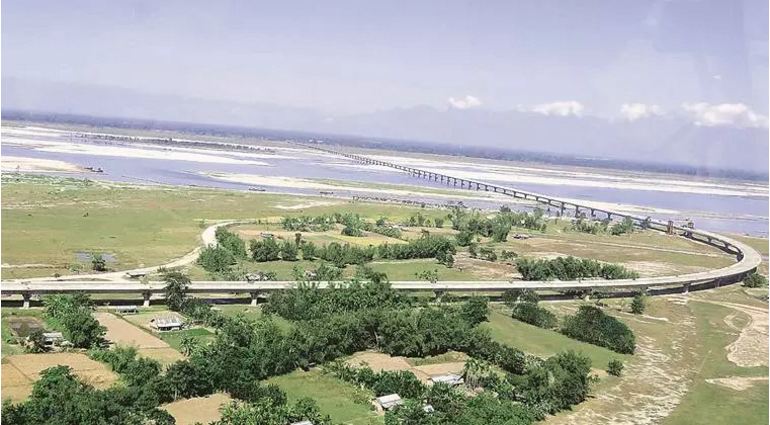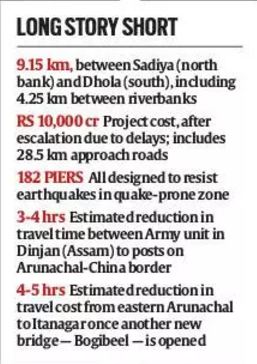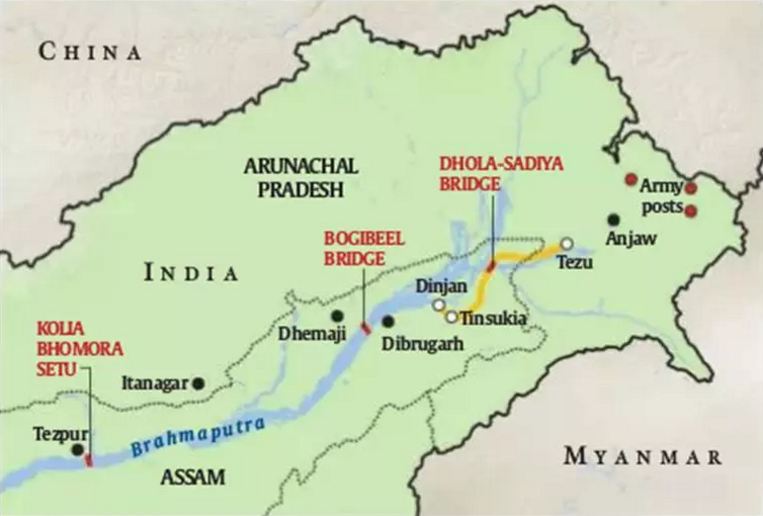Inauguration by PM tomorrow; bridge in Assam will bring Arunachal several hours closer, help Army teams reach border posts faster

Sadiya is one of the most disadvantaged places in Assam, a subdivision of Tinsukia bounded by rivers on three sides: Lohit, Brahmaputra and Dibang. On Friday, it will present the neighbourhood with a landmark in connectivity.
Prime Minister Narendra Modi will inaugurate the country’s longest bridge, connecting Dhola on the Brahmaputra’s south bank to Sadiya on the north. At 9.15 km, the bridge is longer than the Bandra-Worli Sea Link (5.6 km) by nearly two-thirds.
The fourth bridge on the Brahmaputra, it will boost communication across eastern Arunachal Pradesh. The most significant beneficiary will be the Army, whose convoys will now save an estimated three to four hours in their journey from Assam to their posts at Kibithoo, Wallong and Chaglagam on the Arunachal-China border.
Sadiya, birthplace of Bhupen Hazarika, was once a thriving town until an earthquake struck on August 15, 1950. “I was a boy then,” said Bhaba Gogoi, 82, gaonburra of Boiragimath village north of the bridge. “The Brahmaputra changed course and took away half of Sadiya town within days, and the rest in the early 1970s. I am thankful to God that I have lived long enough to see a bridge in this once godforsaken place.”
The Northeast being a high seismic region, the bridge was built using state-of-the-art equipment, including imported hydraulic rigs, and provided seismic buffers in all its 182 piers, said B Surya Raju, chief manager (projects) with Navayuga Engineering Co Ltd, a Bengaluru-based company that specialises in various kinds of structures including bridges and jetties.
 Hopes fulfilled
Hopes fulfilled
Prasanta Buragohain, a bureaucrat in Assam, recalls a letter he wrote in 1980 to the North-Eastern Council. “I hail from Sadiya, and know how challenging it has been for us to reach the world outside. Along with Gobinda Borbora, an elderly citizen, I submitted an application to the NEC demanding a bridge between Dhola and Sadiya,” Buragohain said.
In May 2003, Rajya Sabha MP Arun Kumar Sarma and Sadiya MLA Jagadish Bhuyan — both then with the AGP — wrote to C P Thakur, then minister for Development of North-Eastern Region, proposing such a bridge. That June, Arunachal chief minister Mukut Mithi wrote to prime minister Atal Bihari Vajpayee: “The eastern part of Arunachal Pradesh is sensitive from the strategic point of view. In 1962, Wallong and Kibithoo were scenes of fierce battles, and the absence of proper surface communication was the main factor why the Indian Army suffered massive losses.”
 In August 2003, the road transport and highways ministry cleared a feasibility study.
In August 2003, the road transport and highways ministry cleared a feasibility study.
Construction began in 2011 and the original target date for completion was December 2015.
“We could have completed the bridge at least one year ago, but for two main problems — the geology here that makes the soil too sandy and silty, and the monsoon and floods that take away five to six months every year,” said Raju, the construction company executive. “We also had some land acquisition issues… which were resolved only in February this year.”
The delays raised the project cost from an initial Rs 6,600 crore to about Rs 10,000 crore. The project included construction of 28.5 km approach roads.
Assam and Arunachal Pradesh
“The bridge will immensely help the Army in swift mobilisation and movement of troops and heavy equipment to the frontier areas. The Army had been pressing for this bridge for a long time,” said Brigadier (retired) Ranjit Borthakur.
As of now, Army convoys in Assam either spend hours crossing the river by boat from Dhola to Sadiya, or take a circuitous 10-hour, 250 km road trip from Dinjan division HQ, near Tinsukia, to Tezu in Arunachal, before driving ahead to the border.
“The bridge will immensely benefit Arunachal Pradesh,” said Chowna Mein, the state’s deputy CM. “While movement of goods will become smoother, our people will have faster access to healthcare and education. Tourism will also receive a big push with eastern Arunachal becoming easily accessible.”
Chow Miko Longphong, a former director of information and public relations with the Arunachal government, recalled his college days in Dibrugarh in the late 1970s. “We would start before sunrise from our village, Lathao, walk about 12 km, cross the Noa-Dihing and walk another 25 km to Kakopathar in Assam. Tempos there would take us to Doomdooma town, then a government bus to Tinsukia. If everything went well, we would catch the last bus to Dibrugarh, otherwise spend the night in Tinsukia.”
Even today, it takes eight to ten hours from the border district of Anjaw to Tezu, followed by another eight hours to Tinsukia or five hours to Dibrugarh. The new bridge will cut this travel time by four to five hours.
The journey from eastern Arunachal to Itanagar, too, will come down once another bridge on the Brahmaputra is completed. “Once the Bogibeel bridge between Dibrugarh and Dhemaji is complete, we will be able to reach Itanagar in six or seven hours,” said Chow Wasina Manchey of Tezu.
Now, a traveller from Anjaw to Itanagar has to cross the Brahmaputra at two ghats by ferry — Sadiya-Dhola and Dibrugarh-Dhemaji — or take a 14-hour road route.
The boatmen
Until December 2016, about 150 boats —about 100 single boats and the rest mar-boats (two boats with a single platform to transport buses and loaded trucks) — were plying between Saikhowaghat (Dhola) and Sadiya.
“When Army convoys arrive, we deploy almost all our boats leaving a couple for civilians. We don’t charge the Army anything; rather, they fill our drums with diesel,” said Vijay Pratap Singh, originally of Bihar, who operates a fleet from the Dhola side.
Until a few months ago, around 5,000 people, 60 to 70 trucks and 100 cars used to cross the river by boat between Dhola and Sadiya every day, mostly to Arunachal. In recent months, a bridge each has been commissioned on the Noa-Dihing and the Lohit, and about 40 per cent of the traffic has shifted out. With the Dhola-Sadiya bridge ready, some 50 boat-owners have begun packing up and are looking for buyers from the few remaining ghats downstream of Dhola and Sadiya.
“The bridge will throw 2,000 persons out of work — boat-owners, boatmen, labourers, shopkeepers, taxi drivers,” said Singh, who has been in the ferry business for four decades. “But the loss we 2,000 people suffer will benefit millions of others.”
Source: The Indian Express

